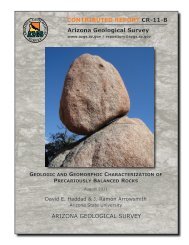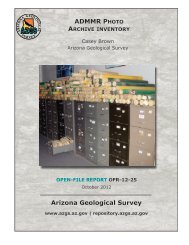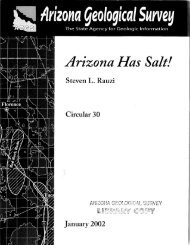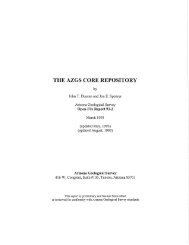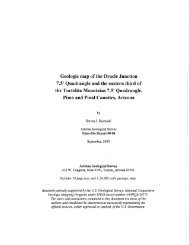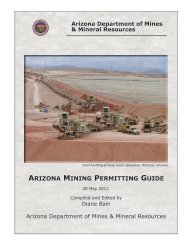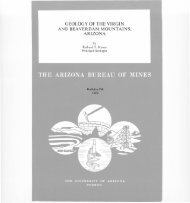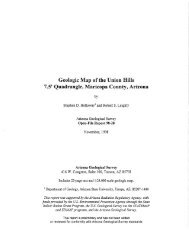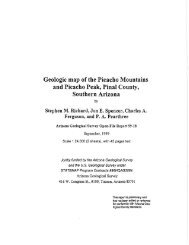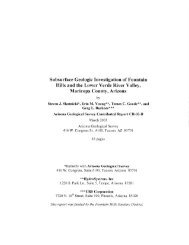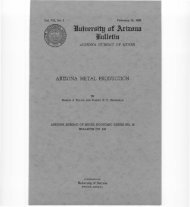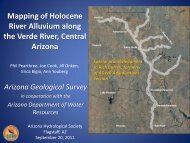Geologic Map of the Galleta Flat East 7.5 - AZGS Document ...
Geologic Map of the Galleta Flat East 7.5 - AZGS Document ...
Geologic Map of the Galleta Flat East 7.5 - AZGS Document ...
Create successful ePaper yourself
Turn your PDF publications into a flip-book with our unique Google optimized e-Paper software.
<strong>Geologic</strong> <strong>Map</strong> <strong>of</strong> <strong>the</strong> <strong>Galleta</strong> <strong>Flat</strong> <strong>East</strong><br />
<strong>7.5</strong>' Quadrangle, Cochise County, Arizona<br />
Ann Youberg, Joseph P. Cook, Jon. E. Spencer and<br />
Stephen M. Richard<br />
Arizona <strong>Geologic</strong>al Survey Digital <strong>Geologic</strong> <strong>Map</strong> DGM-56,<br />
version 2.0<br />
1:24,000 scale (1 sheet)<br />
April 2009<br />
with 6 p. text<br />
Arizona <strong>Geologic</strong>al Survey<br />
416 W. Congress St., Suite 100, Tucson, AZ 85701<br />
www.azgs.az.gov<br />
This geologic map was funded in part by <strong>the</strong> USGS National<br />
Cooperative <strong>Geologic</strong> <strong>Map</strong>ping Program, award no. 05HQAG0078<br />
The views and conclusions contained in this document are those <strong>of</strong><br />
<strong>the</strong> authors and should not be interpreted as necessarily<br />
representing <strong>the</strong> <strong>of</strong>ficial policies, ei<strong>the</strong>r expressed or implied, <strong>of</strong> <strong>the</strong><br />
U.S. Government.
Introduction<br />
<strong>Geologic</strong> <strong>Map</strong> <strong>of</strong> <strong>the</strong> <strong>Galleta</strong> <strong>Flat</strong> <strong>East</strong> <strong>7.5</strong>' Quadrangle,<br />
Cochise County, Arizona<br />
The <strong>Galleta</strong> <strong>Flat</strong> <strong>East</strong> <strong>7.5</strong>’ Quadrangle is located in northwestern Cochise County in sou<strong>the</strong>astern<br />
Arizona, north <strong>of</strong> <strong>the</strong> town <strong>of</strong> Benson. The San Pedro River flows south to north across <strong>the</strong><br />
quadrangle and has been in a downcutting phase during <strong>the</strong> Quaternary. Lower Quaternary and<br />
upper Pliocene strata, which are exposed in bluffs and low hills flanking <strong>the</strong> river, were deposited in<br />
fluvial and lacustrine-margin to playa environments (Smith, 1994; Youberg et al., 2003). Bedrock<br />
exposed near <strong>the</strong> nor<strong>the</strong>rn end <strong>of</strong> <strong>the</strong> Quadrangle consists <strong>of</strong> early Proterozoic Johnny Lyon<br />
Granodiorite and Pinal Schist (Cooper and Silver, 1964; Drewes, 1974).<br />
Quaternary map units<br />
Piedmont Alluvium<br />
Quaternary piedmont deposits derived from <strong>the</strong> Rincon and Whetstone mountains to <strong>the</strong> west and<br />
Little Dragoon and Winchester mountains to <strong>the</strong> east <strong>of</strong> <strong>the</strong> San Pedro River cover most <strong>of</strong> <strong>the</strong> <strong>Galleta</strong><br />
<strong>Flat</strong> <strong>East</strong> quadrangle. This alluvium was deposited by larger tributary streams that head in <strong>the</strong><br />
mountains and smaller streams heading in <strong>the</strong> upper piedmont. Abbreviations are “ka”, thousands <strong>of</strong><br />
years before present, and “Ma”, millions <strong>of</strong> years before present.<br />
Qyc – Modern stream channel deposits — Active channel and gravel bar deposits composed <strong>of</strong><br />
very poorly-sorted sand, pebbles, and cobbles with some boulders to moderately-sorted sand<br />
and pebbles. Channels are extremely flood prone and are subject to deep, high velocity in<br />
moderate to large flow events, and severe lateral bank erosion.<br />
Qy3 - Latest Holocene alluvium — Recently active piedmont alluvium located primarily along active<br />
drainages including floodplain, low-lying terrace, and overflow channels. Qy3 deposits are<br />
composed <strong>of</strong> unconsolidated to very weakly consolidated silty to cobbly deposits and exhibit<br />
greater vegetation than Qyc deposits. These deposits generally exhibit bar and swale<br />
microtopography and are susceptible to inundation during moderate to extreme flow conditions<br />
when channel flow exceeds capacity. Soil development is generally absent or incipient on Qy3<br />
deposits which exhibit pale buff to light brown (10 YR) surface coloration.<br />
Qyaf - Late Holocene alluvium, active fan deposits — Young, active alluvial fan deposits in <strong>the</strong><br />
San Pedro River valley, at <strong>the</strong> base <strong>of</strong> piedmonts. These alluvial fans are active and extremely<br />
prone to flooding.<br />
Qy2 - Late Holocene alluvium — Young deposits in low terraces and small channels that are part <strong>of</strong><br />
<strong>the</strong> modern drainage system. Channels are flood prone and may be subject to deep, high velocity<br />
flows in large flow events.<br />
Qy1 – Older Holocene alluvium — Older Holocene terraces found at scattered locations along<br />
incised drainages throughout <strong>the</strong> study area, and isolated alluvial fans at <strong>the</strong> base <strong>of</strong> <strong>the</strong><br />
piedmont. Qy1 surfaces are higher and less subject to inundation than adjacent Qy2 surfaces.
Qys – Fine-grained Holocene alluvium derived from <strong>the</strong> St. David Formation — Thin (< 2m) to<br />
discontinuous fine-grain Holocene alluvium overlying basin fill deposits (units Ts, QTcs). Qys<br />
deposits are typically fine-grained active alluvial fans at <strong>the</strong> base <strong>of</strong> basin fill outcrops along <strong>the</strong><br />
edges <strong>of</strong> <strong>the</strong> peidmonts.<br />
Qi3 - Late Pleistocene alluvial fan and terrace deposits — Slightly to moderately dissected relict<br />
alluvial fans and terraces. Qi3 terraces along major washes tend to be strath terraces in basin fill<br />
deposits with thin (
quadrangle, clasts include probably Scanlon Conglomerate derived from <strong>the</strong> Pioneer Shale <strong>of</strong> <strong>the</strong><br />
Apache Group, which is exposed to <strong>the</strong> nor<strong>the</strong>ast in <strong>the</strong> Johnny Lyon Hills (Cooper and Silver,<br />
1964). Interpreted as alluvial fan deposits shed into San Pedro River Valley from flanking<br />
bedrock hills and mountains.<br />
QTcs – Pliocene-Pleistocene conglomerate and sandstone – Coarse, poorly sorted, tan<br />
sandstone, conglomeratic sandstone, and conglomerate. Some sandstone and conglomeratic<br />
sandstone are pinkish tan to reddish tan to reddish medium brown. Poorly to moderately defined<br />
beds are generally 20 to 100 cm thick. Most clasts are 1-20 cm diameter, locally to 50 cm.<br />
Conglomerate clasts are mostly granitic and subangular to subrounded. Conglomeratic<br />
sandstone beds commonly contain channels and channel fill pebbles and cobbles that are<br />
coarser than host. Typical channel is 1 m wide and 20 cm deep. Some beds have 2-20 mm<br />
granules and pebbles in lower 5-10 cm, with crudely graded beds. Locally, near basin axis but<br />
adjacent to bedrock outcrops, unit consists <strong>of</strong> poorly bedded and poorly sorted sandstone with<br />
spars 1-10 cm angular granite debris. This unit interfingers with units QTc near its top and Ts<br />
near its base.<br />
Ts – Pliocene red sandstone, silty sandstone, and siltstone – Massive to bedded, reddish brown<br />
(5YR to 10YR) sandstone, siltstone, and mudstone that forms low-relief outcrops. Outcrops<br />
are commonly mantled in dried mud with polygonal fractures that possibly formed by<br />
expansion <strong>of</strong> clay minerals. This unit correlates to <strong>the</strong> lower Saint David Formation <strong>of</strong> Gray<br />
(1965), and Smith (1994).<br />
San Pedro River Alluvium<br />
Sediment deposited by <strong>the</strong> San Pedro River in <strong>the</strong> middle <strong>of</strong> <strong>the</strong> map area. Deposits are a mix <strong>of</strong><br />
gravel, cobble, sand and finer material; <strong>the</strong>y exhibit mixed lithologies and a higher degree <strong>of</strong> clast<br />
rounding, reflecting <strong>the</strong> large drainage area <strong>of</strong> this watershed. Virtually all <strong>of</strong> <strong>the</strong> area covered by<br />
Holocene river deposits has been altered by intense agricultural so <strong>the</strong>re is greater uncertainty<br />
regarding <strong>the</strong> locations <strong>of</strong> unit contacts than in piedmont areas. Pleistocene river terrace deposits are<br />
thin, up to 3m thick, over strath basin fill deposits, typically unit Ts.<br />
Qycr - Active river channel deposits — Deposits are dominantly unconsolidated, very poorly sorted<br />
sandy to cobbly beds exhibiting bar and swale microtopography but can range from fine silty<br />
beds to coarse gravelly bars in meandering reaches based on position within <strong>the</strong> channel.<br />
Clasts are typically well-rounded but may be angular to sub angular. Qycr deposits are typically<br />
unvegetated to lightly vegetated and exhibit no soil development. Qycr deposits are<br />
entrenched from 30 cm to 5 meters or more below adjacent early historical floodplain deposits<br />
depending on location, geomorphic relationship, and local channel conditions. Although much<br />
<strong>of</strong> <strong>the</strong> San Pedro River was a perennial stream historically, some modern sections are dry or<br />
marshy at <strong>the</strong> surface throughout much <strong>of</strong> <strong>the</strong> year. These deposits are <strong>the</strong> first to become<br />
submerged during flow events and can be subject to deep, high velocity flow and lateral bank<br />
erosion.<br />
Qy3r – Historical river terrace deposits — Terrace deposits occupying elevations from 1 to 2 meters<br />
above Qycr deposits and inset below <strong>the</strong> pre-incision historical floodplain. These surfaces are<br />
generally planar but exhibit bar and swale microtopography. Although little to no soil<br />
development is present, dense grasses and small mesquite trees abound. Sediments<br />
composing <strong>the</strong>se deposits are poorly sorted silt, sand, pebbles and cobbles. Pebbles and<br />
cobbles are well-rounded to sub-angular. Trough crossbedding, ripple marks, and stacked<br />
channel deposits viewable in cross-section indicate deposition in a low to moderate energy<br />
4
aided stream environment. These deposits are prone to flooding during extreme flow events,<br />
and undercutting and rapid erosion <strong>of</strong> Qy3r surfaces is possible during lower flow events.<br />
Qy2r – Latest Holocene to historical river terrace deposits — Deposits associated with <strong>the</strong><br />
floodplain that existed prior to <strong>the</strong> early historical entrenchment <strong>of</strong> <strong>the</strong> San Pedro River<br />
(Hereford, 1993; Huckleberry, 1996; Wood, 1997). Qy2r deposits are associated with broadly<br />
planar surfaces that locally retain <strong>the</strong> shape <strong>of</strong> historical river meanders. Qy2r surfaces are up<br />
to 7 meters above modern Qycr deposits and are <strong>the</strong> most extensive river terraces in <strong>the</strong><br />
valley. Qy2r sediments were deposited when <strong>the</strong> San Pedro River was a widespread,<br />
shallowly-flowing river system and are dominated by fine grained floodplain deposits. Dense<br />
mesquite bosque and tall grass is typically present on <strong>the</strong>se surfaces except where historic<br />
plowing or grazing has taken place. These surfaces appear predominantly fine grained at <strong>the</strong><br />
surface due in part to <strong>the</strong> input <strong>of</strong> organic matter and windblown dust deposition but are<br />
composed <strong>of</strong> interfingering coarse sandy to pebbly braided channel and fine sand to silty river<br />
floodplain deposits. Where Qy2r deposits are moderately to deeply incised <strong>the</strong>y not subject to<br />
inundation by river floods, but <strong>the</strong>y may be flood-prone in areas with less channel incision.<br />
Qy2r deposits are subject to catastrophic bank failure due to undercutting and lateral erosion<br />
during flow events. Distal piedmont fan deposits (Qy2 ,Qyaf, and Qys) onlap onto Qy2r<br />
deposits although an interfingering relationship likely exits in <strong>the</strong> subsurface.<br />
Qi3r - Late Pleistocene river terrace deposits — River terrace deposits found on ridge ends along<br />
<strong>the</strong> San Pedro River. Qi3r deposits are thin (< 2 m) over strath basin fill deposits, typically unit<br />
Ts, and composed <strong>of</strong> rounded to well-rounded gravels, cobbles, and finer-grained sediment.<br />
Qi2r - Middle to late Pleistocene river terrace deposits — River terrace deposits found on<br />
scattered hilltops along <strong>the</strong> San Pedro River over strath basin fill deposits, typically unit Ts.<br />
Qi2r surfaces are 1-2m above Qi3r terraces.<br />
Qi1r - Early to middle Pleistocene river terrace deposits — River terrace deposits found on<br />
scattered hilltops along <strong>the</strong> San Pedro River over strath basin fill deposits, typically <strong>of</strong> unit Ts.<br />
Qi1r terraces are <strong>the</strong> highest river terraces in <strong>the</strong> map area. They are 2-3m above Qi2r<br />
terraces.<br />
Qir - Pliocene river deposits — Qir is composed <strong>of</strong> a moderately thick sequence <strong>of</strong> coarse, poorlysorted<br />
San Pedro River deposits and consolidated, moderately to well-sorted, channel<br />
conglomerates that underlie Pleistocene river terrace deposits. channel conglomerates exhibit<br />
trough cross-bedding with a north-south trend. This unit sits directly on <strong>the</strong> lowest basin fill unit<br />
(map unit Ts).<br />
O<strong>the</strong>r Units<br />
d - Disturbed areas – stock tanks and ditches<br />
Qtc – Quaternary hillslope talus and colluvium – Colluvial deposits that form at <strong>the</strong> base <strong>of</strong><br />
bedrock slopes. These deposits tend to be composed <strong>of</strong> angular to subangular cobbles and<br />
boulders derived from adjacent bedrock.<br />
Bedrock <strong>Map</strong> Units<br />
md - Mafic dike (Proterozoic to Tertiary) – Dark, typically fine-grained dikes containing abundant<br />
plagioclase and hornblende and/or pyroxene. One dike, located in <strong>the</strong> northwest quarter <strong>of</strong><br />
section 30, in <strong>the</strong> northwest corner <strong>of</strong> <strong>the</strong> map area (UTME 561837, UTMN 3552304, NAD 83,<br />
5
zone 12), appears in thin section to be >99% pyroxene. There is some uncertainty in <strong>the</strong><br />
identification as pyroxene, however. In thin section <strong>the</strong> pyroxene(?) appears as anhedral,<br />
colorless to very weakly pleochroic, with maximum second-order blue birefringence. It is<br />
unclear if <strong>the</strong> rock sample on <strong>the</strong> thin section is at <strong>the</strong> standard 30 micron thickness because<br />
<strong>the</strong>re is no quartz that can be used to calibrate <strong>the</strong> thickness. Lack <strong>of</strong> pleochroism in<br />
hornblende could be due to excessive grinding resulting in a thin section that is too thin.<br />
However, it is thought that this rock is, in fact, a fairly fresh pyroxenite (sample 1-3-06-2).<br />
Xgj - Johnny Lyon granodiorite (Paleoproterozoic) - Equigranular to weakly porphyritic, medium to<br />
fine grained granodiorite or granite. In areas where deformation and alteration are minimal,<br />
biotite phenocrysts are up to 4 mm diameter, and feldspar (probably K-feldspar) is up to 12 mm<br />
diameter. Weakly to moderately porphyritic character is obscured by alteration in most areas.<br />
In sparse areas <strong>of</strong> minimal alteration <strong>the</strong> granodiorite consists <strong>of</strong> approximately 60%, whitish<br />
feldspar, mostly in grains
Haney, J., and Lombard, J., 2005, Interbasin groundwater flow at <strong>the</strong> Benson Narrows, Arizona:<br />
Southwest Hydrology, v. 4, n. 2, p. 8-9.<br />
Hereford, R., 1993, Entrenchment and widening <strong>of</strong> <strong>the</strong> upper San Pedro River, Arizona: <strong>Geologic</strong>al<br />
Society <strong>of</strong> America Special Paper 182, 46 p.<br />
Huckleberry, Gary, 1996, Historical channel changes on <strong>the</strong> San Pedro River, sou<strong>the</strong>astern Arizona:<br />
Arizona <strong>Geologic</strong>al Survey Open-File Report 96-15, 35 p.<br />
Johnson, N,M., Opddyke, N.D., and Lindsay, E.H., 1975, Magnetic polarity <strong>of</strong> Pliocene-Pleistocene<br />
terrestrial deposits and vertebrate faunas, San Pedro Valley, Arizona. <strong>Geologic</strong>al Society <strong>of</strong><br />
Americal Bulletin, v. 86, 5-12.<br />
Lindsay, E.H., Smith, G.A., Haynes, C.V., and Opdyke, N.D., 1990, Sediments, geomorphology,<br />
magnetostratigraphy, and vertebrate paleontology in <strong>the</strong> San Pedro Valley, Arizona. Journal <strong>of</strong><br />
Geology, v. 98, p. 605-619.<br />
Slate, J.L., Smith, G.A., Yang, Wang, and Cerling, T.E., 1996, Carbonate-paleosol genesis in <strong>the</strong> Plio-<br />
Pleistocene Saint David Formation, sou<strong>the</strong>astern Arizona. Journal <strong>of</strong> Sedimentary Research, v. 1,<br />
p. 85-94.<br />
Smith, G.A., 1994, Climatic influences on continental deposition during late-stage filling <strong>of</strong> an<br />
extensional basin, sou<strong>the</strong>astern Arizona. <strong>Geologic</strong>al Society <strong>of</strong> America Bulletin, v. 106, p. 1212-<br />
1228.<br />
Smith, G.A., 2000, Recognition and significance <strong>of</strong> streamflow-dominated piedmont facies in<br />
extensional basins. Basin Research, v. 12, p. 399-411.<br />
Silver, L.T., 1955, The structure and petrology <strong>of</strong> <strong>the</strong> Johnny Lyon Hills area, Cochise County,<br />
Arizona: Pasadena, California, California Institute <strong>of</strong> Technology, unpublished Ph.D. dissertation,<br />
407 p.<br />
Smith, G.A., 1994, Climatic influences on continental deposition during late-stage filling <strong>of</strong> an<br />
extensional basin, sou<strong>the</strong>astern Arizona: <strong>Geologic</strong>al Society <strong>of</strong> America Bulletin, v. 106, p. 1212-<br />
1228.<br />
Wood, M.L., 1997, Historical channel changes along <strong>the</strong> lower San Pedro River,<br />
sou<strong>the</strong>astern Arizona: Arizona <strong>Geologic</strong>al Survey Open-File Report 97-21, 44 p., 3<br />
sheets, scale 1:24,000.<br />
Youberg, A., Skotnicki, S., Shipman, T.C., and Ferguson, C.A., 2003, <strong>Geologic</strong> map <strong>of</strong> <strong>the</strong> Benson 7<br />
½' Quadrangle, Cochise County, Arizona: Arizona <strong>Geologic</strong>al Survey Digital <strong>Geologic</strong> <strong>Map</strong> DGM-<br />
34, scale 1:24,000.<br />
7



